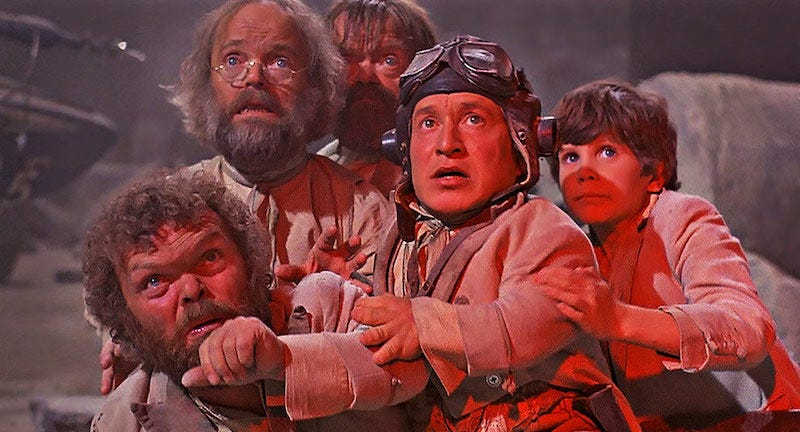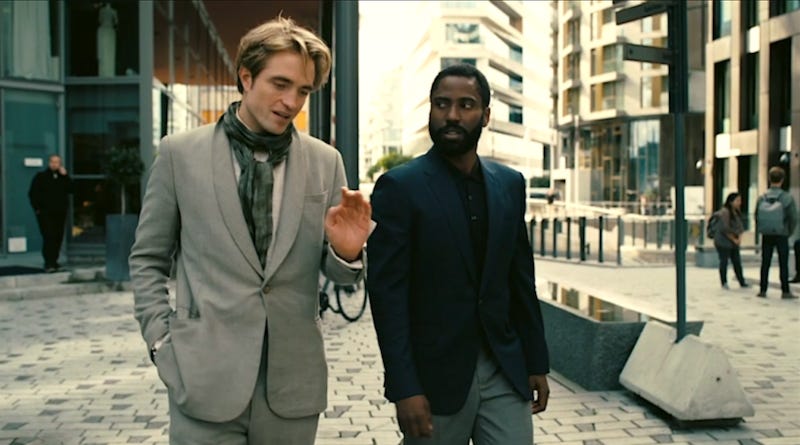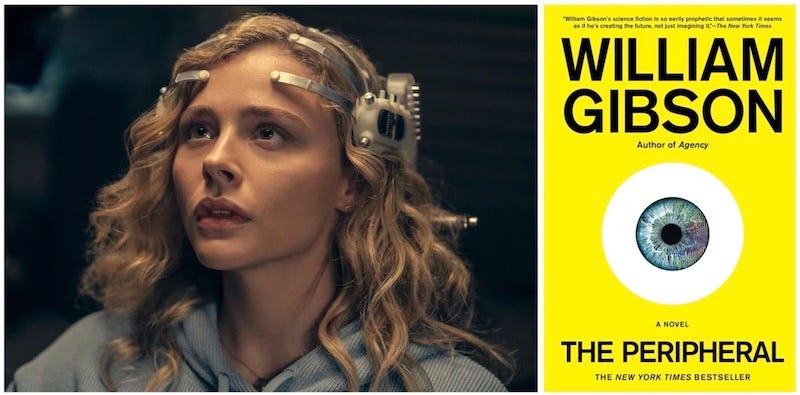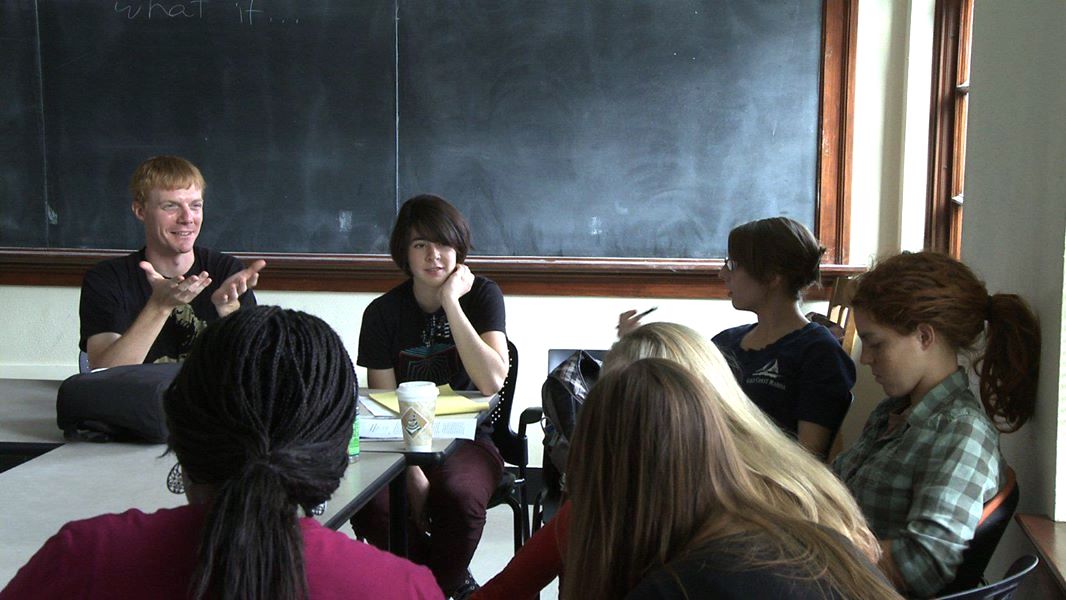The time-travel trope never seems to wear thin. Even a bad time-travel story has its moments. Madeleine L’Engle’s A Wrinkle in Time (1962) was the first full-length novel I ever read, and something about it latched onto my sixth-grade imagination and hasn’t let go. Several of my favorite all-time stories involve time travel to some extent.
“Part of the fascination of time travel concerns the stark paradoxes that threaten as soon as travel into the past is considered,” writes the theoretical physicist Paul Davies in his 2001 book How to Build a Time Machine. “Perhaps causal loops can be made self-consistent. Perhaps reality consists of multiple universes.” These thought experiments are rife with unanswered and unanswerable questions, which are the very stuff of great stories.

Though the concept started in religion, it was popularized by H.G. Wells’ 1895 novella, The Time Machine. Mechanical time travel has remained a standard in science fiction ever since. According to James Gleick’s Time Travel: A History (Pantheon, 2016), H.G. Wells wasn’t trying to explain anything. He was just trying to come up with a “plausible-sounding plot device” for a story.
There are the plausible-sounding back-in-time explorations like the Back to the Future franchise (1985-1990), and the time-loop lunacy of Groundhog Day (1993), as well as the outright hysterics of Hot Tub Time Machine (2010) and Hot Tub Time Machine 2 (2015), but they’re not all winners. Project Almanac (2015) illustrates the inherent paradoxes of temporal travel and their intrigue while still being only an okay movie, but it falters in spite of the time travel rather than because of it. 2009’s Triangle also loops time into a muddy and often confusing story. Time travel can be such a cumbersome cognitive load that it’s difficult to get right in a story with much else going on and even harder to make feel real. And then of course there’s Justin Smith Ruiu’s ChronoSwoop app.
With that said, here are twenty-three of my favorite stories that feature time travel in one form or another.
“Time is a game
played beautifully
by children.”
— Heraclitus, Fragment 79
Time Bandits

The story that best captures my childhood fascination with adventure—and directly follows the feeling I got from A Wrinkle in Time—is Terry Gilliam’s Time Bandits (1981). Reluctant to go to bed, a young boy (Kevin) is soon whisked away by a band of tiny time-traveling thieves who’ve stolen a map of the universe from the Supreme Being. Through portals marked on the map, they bounce through time, stealing whatever they can along the way. Though young Kevin has been longing for adventure, soon all he wants is to get back home.
Primer

Written, directed, produced, edited, and scored by Shane Carruth, who also costars, Primer (2004) is a D.I.Y. garage sci-fi thriller. It got a lot of attention upon its release in 2004 for its bargain budget, but it’s an achievement at any price. Friends and engineering colleagues Aaron (Carruth) and Abe (David Sullivan) build a box that turns out to enable them to travel back in time. The fact that they stumble upon this ability and then use it for fairly frivolous means (stock trades) doesn’t dull the chronologically jumbled plot or the inevitable unraveling of their relationship.
Palm Springs

Right when you thought the time-loop concept was past tense, it comes back around again, just as renewed and refreshed as it is recurring. A destination wedding is the setting for the temporal hijinks in Max Barbakow’s Palm Springs (2020). Like the Harlequin in Harlan Ellison’s “‘Repent, Harlequin!’ Said the Ticktockman,” who deliberately knocks a clockwork world out of its scheduled whack, Nyles (Andy Samberg) breaks everyone out of their routines and shows them a different way through the wedding day, over and over again, until Roy (J.K. Simmons) and Sarah (Cristin Milioti), er, shake things up for him.
Timecrimes

Timecrimes (Los Cronocrímenes; 2007) capitalizes on its causal loops and suspenseful twists rather than wasting them. The film contains exactly four actors, and its action takes place over the course of about an hour and a half. In its handling of causality, Timecrimes is somewhere between Primer and the popular Back to the Future franchise of the 1980s, both of which feature extensive backwards time travel. Like Primer, which uses time travel as the pretext for the study of larger issues, Timecrimes evokes themes of voyeurism and ethics in addition to its time-looping structure and the subsequent questions of causality. [See my full write-up in the Econo Clash Review.]
Safety Not Guaranteed

Inspired by a classified ad that ran in Backwoods Home Magazine in 1997, Safety Not Guaranteed (2012) shows how the possibilities of time travel test our loyalties. All of the film’s characters are faced with decision points that didn’t exist before but that point back to issues they should’ve already processed: one applying for medical school, one tracking down his high-school flame, one seemingly above everything anyway. It’s a surprisingly poignant and effective movie.
How to Live Safely in a Science Fictional Universe

The narrator in Charles Yu’s How to Live Safely in a Science Fictional Universe (Vintage, 2010) is a time-machine mechanic. Charles (the narrator has the same name as the author) travels around in his TM-31 Recreational Time Travel Device, alone save his AI supervisor Phil, his onboard computer TAMMY, and his imaginary dog Ed. His mom is stuck in a time-loop, and his dad—inventor of the TM-31—is missing. That premise and those few details unfold into some interesting possibilities and wild predicaments.
Tenet

Before Tenet (2021), the writer and director Christopher Nolan was often criticized for being all head and no heart, but when he ventures too far into love (e.g., Inception and Interstellar), he falters. With Tenet, Nolan seems to stay with his strengths, one of those being the technical intricacies of time travel. Here it’s not so much time travel as we think of it but reversed entropy. So, within this ontology, if one wants to go back in time, one must travel through that piece of time backwards (i.e., you can’t blink back to last Tuesday; you have to go backwards through all the days since then to get there). This yields unique results and finds Nolan at the peak of his powers. Though someone described Tenet as “a puzzle box with nothing inside,” I say it’s well worth the puzzlin’.
The Shining Girls

“The problem with snapshots,” Kirby Mazrachi thinks, “is that they replace actual memories. You lock down the moment and it becomes all there is of it.” Kirby is one of the girls in The Shining Girls by Lauren Beukes (Mulholland Books, 2013), a disturbingly beguiling novel that is now an Apple TV series in which Elisabeth Moss plays Kirby. Beukes’ easily digestible prose and gleefully nagging narrative betray a convoluted timeline and staggering depth of research. Drifter Harper Curtis (played in the show by Jamie Bell) quantum leaps from time to time gutting the girls as he goes. The House he squats in his helper, enabling the temporal jaunts. He’s like an inverted Patrick Bateman: no money, all motive. Where Bateman’s stories are told from his point of view in the tones of torture-porn, Harper’s kills are described from the abject horror of the victims. And the victims, who are all strong-willed women with drive and purpose, are only victims at his hand. Otherwise they shine with potential and promise. [Read my full review.]
Happy Death Day and Happy Death Day 2U

Time-loops don’t get any loopier than this. One of the genius turns in the script for Groundhog Day, written by Danny Rubin and Harold Ramis, was their use of the Kübler-Ross model of the five stages of grief—denial, anger, bargaining, depression, and acceptance—as an outline for the loops. Christopher Landon’s Happy Death Day (2017) follows Tree (Jessica Rothe) stumbling through a similar cycle. In its sequel, Happy Death Day 2U (2019), a different person is stuck in the next day, and given her repeated previous experience, Tree steps in to help. And a third Happy Death Day is on the way!
12 Monkeys

A core thread of 12 Monkeys is Gaston Bachelard’s Cassandra Complex, in which one is given knowledge of the future, but is unable to convince anyone that the knowledge is true. Inspired by a 1964 French short called La Jetée written and directed by Chris Marker, Terry Gilliam expanded it in 1995 into a feature film starring Bruce Willis, Brad Pitt, Madeline Stowe, and David Morse. James Cole (Willis) is a prisoner in a decimated 2035, having been ravaged by a virus released in 1996. Cole is sent back to 1995 to try and find the source and stop it, but no one believes his claims of imminent doom.
The Peripheral

After three novels set in the present, The Peripheral (Putnam, 2014) marked William Gibson’s return to the future. The story projects all of the hallmarks of cyberpunk both into the near future and much further afield. In the far future, what passes for a government has figured out how to open new timelines in the past (a.k.a. “stubs”) just prior to an apocalyptic event. As in 12 Monkeys, they’re trying to figure out what happened and somehow benefit from it, exploiting the past for gain in their present. The television adaptation predictably deviates from the novel, but is also pretty great.
The Story of Your Life

Leveraging a very strict interpretation of the Sapir-Whorf hypothesis (i.e., that the language you speak creates and shapes the reality you live in), the lead scientist in Ted Chiang’s “The Story of Your Life,” Dr. Louise Banks (played by Amy Adams in Denis Villenueve’s 2016 adaptation, Arrival), starts to see the world through the language of the alien visitors, the heptapods. Their language, like their perception of time, is nonlinear, so Banks begins to experience her story, and that of her daughter’s short life, according to the alien linguistic sequence.
Source Code

What happens to one reality when we change another quantum reality’s outcome? Source Code, the system for which the movie is named, uses the last eight minutes of brain activity we all experience upon death to allow a person to experience a different timeline in another, compatible person (via quantum entanglement and “parabolic calculus”; As William Gibson put it, “The people who complain about Source Code not getting quantum whatsit right probably thought Moon was about cloning.”). The idea of the system is to be able to find out what happened just before a catastrophic event (in this case a train bombing), in order to prevent further events from happening (e.g., a massive dirty bomb set for downtown Chicago). Somewhere between brain stimulation and computer simulation, Source Code does its work. But Captain Coulter Stevens (Jake Gyllenhaal) goes in for one last shot at getting everything just right (like Aaron’s repeated runs in Primer) and manages to manipulate more than the system is supposed to allow.
Kindred
Octavia Butler’s Kindred (Doubleday, 1979) keeps landing her self-styled protagonist (Dana) in the slavery-era of the American South. Though she meets some of her ancestors, her jaunts are unplanned and unpredictable, making this a harrowing read at best. Among many other things, Butler is one of the few authors to address the physical dangers of time travel, as Dana loses an arm during her first temporal trip.
The Hazards of Time Travel
Can you be nostalgic for the future? In Joyce Carol Oates’ The Hazards of Time Travel (Ecco Press, 2018), the 17-year-old Adriane Strohl is exiled 80 years in her past (1959), finds another expatriate from their present (2039) and thus begins a time-fraught, dystopian love story.
The Time Traveler’s Wife
Audrey Neffenegger’s debut novel, The Time Traveler’s Wife (MacAdam/Cage, 2003), has already been generative enough to yield a movie and a TV series. In another interesting take on temporal logistics, the time-traveler himself, Henry, makes his unexpected jumps due to a genetic disorder.
Donnie Darko
I’ve already written quite a bit about Richard Kelly’s 2001 Halloween myth, Donnie Darko, but it deserves mention for Kelly’s attempt at constructing a comic-book logic of time travel. As somnambulistic as it is, from the very beginning of the movie, something is off, and the traveler is drawn to fix it. He leverages help from unwitting friends, family, and authority figures to correct the anomoly. [Read my full write-up.]
This is How You Lose the Time War
Cowritten by Amal El-Mohtar and Max Gladstone, This is How You Lose the Time War (Saga Press, 2020) chronicles the correspondence between two lovers/enemies in a war over the fate of the universe. This epistolary novel is written from the highest vantage point on time and space I’ve ever seen. Its time travel is only due to its scale. It’s difficult to even describe the scope of it, but thankfully the drama between them is relatable to all.
Before I Fall
Lauren Oliver’s Before I Fall (HarperCollins, 2010) puts a YA twist on yet another time-loop story that flows through different stages of purpose and grief. Seventeen-year-old Sam Kingston keeps having to redo February 12, “Cupid’s Day,” and has to keep doing it until she gets it right. Sam approaches the repeated day in ways she wouldn’t normally, surprising her friends and family. Like the novel, the movie—starring Zoey Deutch as Sam—is somehow both dark and uplifting.
Recursion
Blake Crouch has written several compelling stories: Dark Matter (Ballantine, 2017), the Wayward Pines trilogy (the basis for the TV show of the same name), and Upgrade (Ballantine, 2023), among others, but none ignited my mind quite like Recursion (Ballantine, 2020). A billionaire-funded neuroscientist doing memory research on one side, and a detective investigating False Memory Syndrome on the other. When they meet in the middle, well… Things get crazy.
Paper Girls
Brian K. Vaughn and Cliff Chiang’s Paper Girls (Image Comics, 2015-2019) tells the story of four girls on their paper route one morning in the 1980s, who suddenly find themselves in the middle of an intergalactic war being fought across time. There’s an Amazon TV show of this one, too. It’s like Stranger Things but better in every way.
Detention
Joseph Kahn’s 2011 genre-melting thriller Detention is a wild, wild ride. It’s like The Breakfast Club meets The Faculty meets Back to the Future. Through their school mascot, a giant grizzly bear (the time “machine”), secrets about these misfits in detention, the principle who put them there, and their collective past are revealed. Oh, also one of them is a serial killer.
The Future of Another Timeline
Once it’s possible to repair the past, which revision remains? Bouncing between 2022 and 1992, The Future of Another Timeline (Tor, 2020) by Annalee Newitz explores the very notion of what time and history actually mean when you can travel through one to change the other, yet also how everything is connected to everything else.
“Just as the river where I step
is not the same, and is,
so am I as I am not.”
— Heraclitus, Fragment 81

